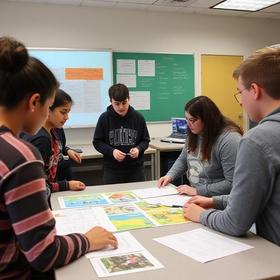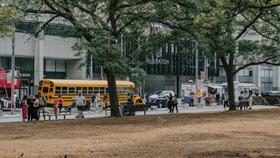Serving 343 students in grades 6-8, Washington Middle School 6-8 ranks in the bottom 50% of all schools in Montana for overall test scores (math proficiency is bottom 50%, and reading proficiency is bottom 50%).
The percentage of students achieving proficiency in math is 27% (which is lower than the Montana state average of 37%). The percentage of students achieving proficiency in reading/language arts is 46% (which is equal to the Montana state average of 46%).
The student-teacher ratio of 15:1 is higher than the Montana state level of 12:1.
Minority enrollment is 10% of the student body (majority American Indian), which is lower than the Montana state average of 23% (majority American Indian).
Quick Facts (2025-26)
- Grades: 6-8
- Enrollment: 343 students
- Student-Teacher Ratio: 15:1
- Minority Enrollment: 10%
- Overall Testing Rank: Bottom 50% in MT
- Math Proficiency: 27% (Btm 50%)
- Reading Proficiency: 46% (Btm 50%)
- Science Proficiency: 30-34% (Btm 50%)
- Source: National Center for Education Statistics (NCES), MT Dept. of Education
School Overview
Washington Middle School 6-8's student population of 343 students has grown by 47% over five school years.
The teacher population of 23 teachers has grown by 21% over five school years.
Grades Offered
Grades 6-8
(Supplemental Virtual)
(Supplemental Virtual)
Total Students
343 students
Gender %
Total Classroom Teachers
23 teachers
Year Founded
1905
Last Day of School
Mon. May 25, 2026
Campus Size
50 acres
School Motto
'Truth and Honor'
School Mascot
Wild Boars
School Rankings
Washington Middle School 6-8 ranks within the bottom 50% of all 696 schools in Montana (based off of combined math and reading proficiency testing data).
The diversity score of Washington Middle School 6-8 is 0.19, which is less than the diversity score at state average of 0.40. The school's diversity has stayed relatively flat over five school years.
Overall Testing Rank
#504 out of 696 schools
(Bottom 50%)
(Bottom 50%)
Math Test Scores (% Proficient)
27%
37%
Reading/Language Arts Test Scores (% Proficient)
46%
46%
Science Test Scores (% Proficient)
30-34%
37%
Student-Teacher Ratio
15:1
12:1
American Indian
6%
10%
Asian
n/a
1%
Hispanic
2%
6%
Black
1%
1%
White
90%
77%
Hawaiian
n/a
n/a
Two or more races
1%
5%
All Ethnic Groups
Participates in the National School Lunch Program (NSLP)
Yes
Eligible for Free Lunch
41%
42%
Eligible for Reduced Lunch
11%
5%
School Statewide Testing
School District Name
Source: National Center for Education Statistics (NCES), MT Dept. of Education
School Notes
- School Mascot: Wild Boars
Profile last updated: 02/09/2025
Frequently Asked Questions
What is Washington Middle School 6-8's ranking?
Washington Middle School 6-8 is ranked #504 out of 696 schools, which ranks it among the bottom 50% of public schools in Montana.
What percent of students have achieved state testing proficiency in math and reading?
27% of students have achieved math proficiency (compared to the 37% MT state average), while 46% of students have achieved reading proficiency (compared to the 46% MT state average).
How many students attend Washington Middle School 6-8?
343 students attend Washington Middle School 6-8.
What is the racial composition of the student body?
90% of Washington Middle School 6-8 students are White, 6% of students are American Indian, 2% of students are Hispanic, 1% of students are Black, and 1% of students are Two or more races.
What is the student-teacher ratio of Washington Middle School 6-8?
Washington Middle School 6-8 has a student ration of 15:1, which is higher than the Montana state average of 12:1.
What grades does Washington Middle School 6-8 offer ?
Washington Middle School 6-8 offers enrollment in grades 6-8 (Supplemental Virtual).
What school district is Washington Middle School 6-8 part of?
Washington Middle School 6-8 is part of Miles City Elementary School District.
School Reviews
Review Washington Middle School 6-8. Reviews should be a few sentences in length. Please include any comments on:
- Quality of academic programs, teachers, and facilities
- Availability of music, art, sports and other extracurricular activities
Recent Articles

What Public Schools Are Doing to Support Mental Health in 2025
An authoritative review of how public schools are expanding mental-health support in 2025 through in-school services, screening, and partnerships for students and families.

Measuring Student Success in Public Schools: Beyond Test Scores
Explore holistic strategies for measuring student success in public schools beyond test scores. Insights for educators, parents, and policymakers in 2025.

Transfer Pathways Between Public School Districts — 2025 Guide
Explore how transferring between public school districts works in 2025 — process, eligibility, documentation and expert tips for families navigating this pathway.





